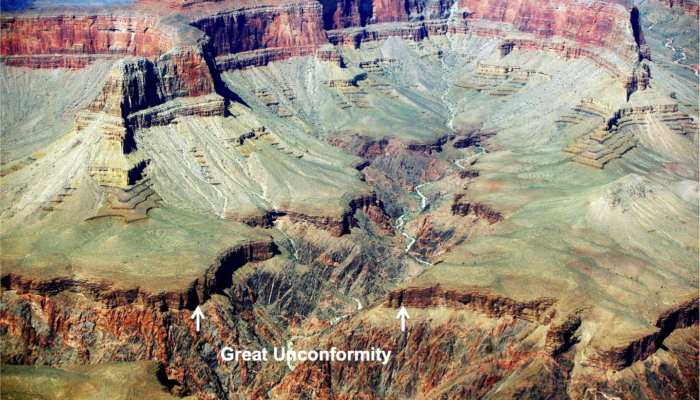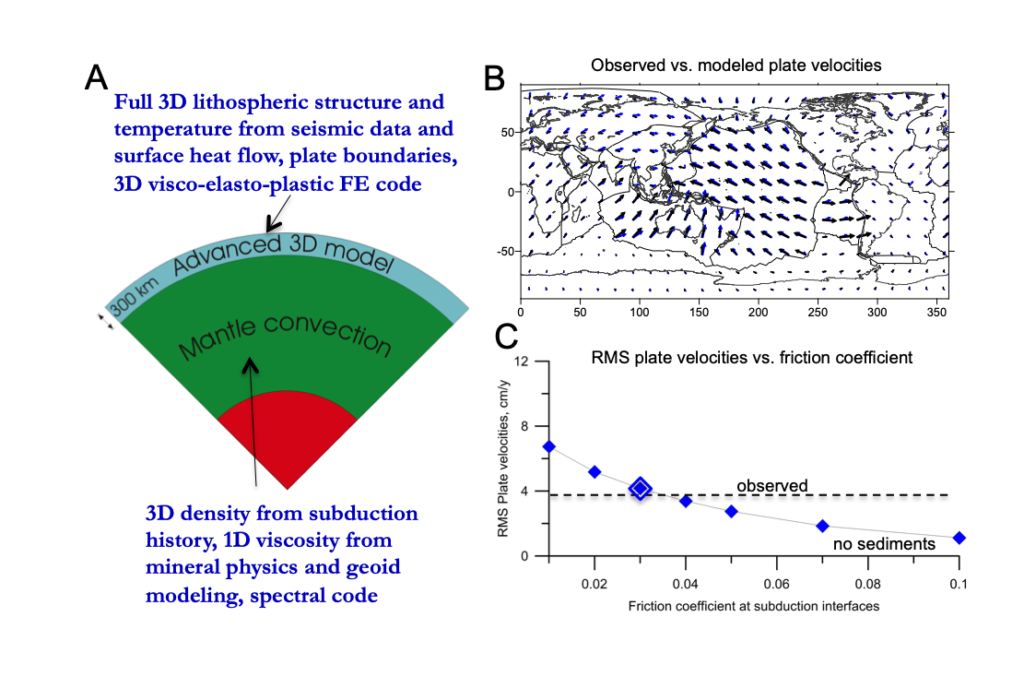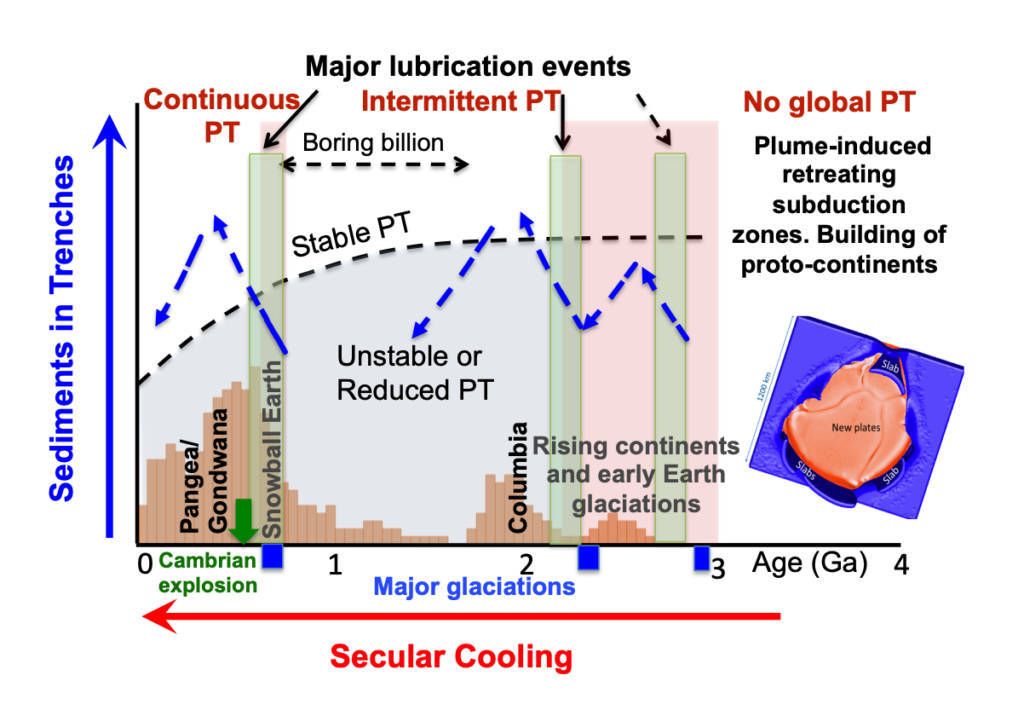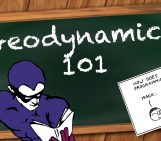

Prof. Dr. Stephan Sobolev. Head of the Geodynamic Modelling section of GFZ Potsdam.
Plate tectonics is a key geological process on Earth, shaping its surface, and making it unique among the planets in the Solar System. Yet, how plate tectonics emerged and which factors controlled its evolution remain controversial. The recently published paper in Nature by Sobolev and Brown suggests new ideas to solve this problem….
What makes plate tectonics possible on contemporary Earth?
It is widely accepted that plate tectonics is driven by mantle convection, but is the presence of said convection sufficient for plate tectonics? The answer is no, otherwise plate tectonics would be present on Mars and Venus and not only on Earth. The geodynamic community recognized that another necessary condition for plate tectonics is low strength at plate boundaries and particularly along the plate interfaces in subduction zones (e.g. Zhong and Gurnis 1992, Tackley 1998, Moresi and Solomatov 1998, and Bercovici 2003). To quantify the required strength at subduction interfaces, we have used global models of plate tectonics (Fig. 1A) that combine a finite element numerical technique employing visco-elasto-plastic rheology to model deformation in the upper 300 km of the Earth (Popov and Sobolev 2008) with a spectral code to model convection in the deeper mantle (Steinberger and Calderwood 2006). The model reproduces well present-day plate velocities if the effective friction at convergent plate boundaries is about 0.03 (Fig.1B). Low strength corresponds to subduction interfaces that are well lubricated by continental sediments (low friction; Lamb and Davis 2003, Sobolev and Babeyko 2005, or low viscosity; Behr and Becker 2018). In case of sediment shortages in the trenches (corresponding to a friction coefficient of 0.07-0.1), plate velocities would first decrease about two times (Fig. 1C) and then even more because of less negatively buoyant material having subducted into the mantle, leading to less convection driving force.

Figure 1. Global numerical model showing the effect of sediments on contemporary subduction. (A) The global model combines two computational domains coupled through continuity of velocities and tractions at 300 km depth. (B) NUVEL 1A plate velocities in a no-net-rotation reference frame (black arrows) versus computed velocities (blue arrows) for the global model with a friction of 0.03 at convergent plate boundaries. (C) Root mean square of computed plate velocities in the global model versus friction coefficient at convergent plate boundaries.
Hypothesis and its testing
Based on the previous discussion, we infer that continental sediments in subduction channels act as a lubricant for subduction. In addition, the presence of these sediments in trenches is a necessary condition for the stable operation of plate tectonics, particularly earlier in Earth’s evolution when the mantle was warmer and slabs were relatively weak. With this hypothesis we challenge the popular view that secular cooling of the Earth was the only major control on the evolution of plate tectonics on Earth since about 3 Ga. The hypothesis predicts that periods of stable plate tectonics should follow widespread surface erosion events, whereas times of diminished surface erosion should be associated with reduced subduction and possibly intermittent plate tectonics.
We test this prediction using geological proxies believed to identify plate tectonics activity (supercontinental cycles) and geochemical proxies that trace the influence of the continental crust on the composition of seawater (Sr isotopes in ocean sediments; Shields 2007) and continental sediments in the source of subduction-related magmas (oxygen and Hf isotopes in zircons; Cawood et al. 2013, Spencer et al. 2017). All three geochemical markers indeed show that just before or in the beginning of supercontinental cycles the influence of sediments is increasing, while it decreases before periods of diminished plate tectonic activity, like the boring billion period between 1.7 and 0.7 Ga (Cawood and Hawkesworth 2014; Fig. 2). The largest surface erosion and subduction lubrication events were likely associated with the global glaciation evens identified in the beginning (2.5-2.2 Ga) and at the end (0.7-0.6 Ga) of the Proterozoic Era (Hoffman and Schrag 2002). The latter snowball Earth glaciation event terminated the boring billion period and kick-started the modern phase of active plate tectonics.
Another prediction of our hypothesis is that in order to start plate tectonics, continents had to rise above sea level and provide sediments to the oceans. This prediction is again consistent with observations: there are many arguments for the beginning of plate tectonics between 3 and 2.5 Ga (see the review of Condie 2018) and, at the same time, this period is most likely when the continents rose above sea level (Korenaga et al. 2017).

Figure 2. Cartoon summarizing the factors that control the emergence and evolution of plate tectonics on Earth. Enhanced surface erosion due to the rise of the continents and major glaciations stabilized subduction and plate tectonics for some periods after 3 Ga and particularly after 0.7 Ga after the cooling of the mantle. Blue boxes mark major glaciations; transparent green rectangles show the time intervals when all three geochemical proxies consistently indicate increasing sediment influence (major lubrication events); and, a thick black dashed curve separates hypothetical domains of stable and unstable plate tectonics. The reddish domain shows the number of passive margins (Bradley 2008), here used as a proxy for plate tectonic intensity.
What was before plate tectonics?
The earlier geodynamic regime could have involved episodic lid overturn and resurfacing due to retreating large-scale subduction triggered by mantle plumes (Gerya et al. 2015) or meteoritic impacts (O’Neill et al. 2017). Retreating slabs would bring water into the upwelling hot asthenospheric mantle, generating a large volume of magma that formed protocontinents. Extension of the protocontinental crust could have produced nascent subduction channels (Rey et al. 2014) along the edges of the protocontinents lubricated by the sediments. In this way, a global plate tectonics regime could have evolved from a retreating subduction regime.
What is next?
Despite of the support from existing data, more geochemical information is required to conclusively test our hypothesis about the role of sediments in the evolution of plate tectonics. Additionally, this hypothesis must be fully quantified, which in turn will require coupled modeling of mantle convection and plate tectonics, surface processes and climate.
References Behr, W. M. and Becker, T. W. Sediment control on subduction plate speeds. Earth Planet. Sci. Lett. 502, 166-173 (2018). Bercovici, D. The generation of plate tectonics from mantle convection. Earth Planet. Sci. Lett. 205, 107–121 (2003). Bradley, D. C. Passive margins through earth history. Earth Sci. Rev. 91, 1-26 (2008). Cawood, P. A., Hawkesworth, C. J. and Dhuime, B. The continental record and the generation of continental crust. Geol. Soc. Amer. Bull. 125, 14-32 (2013). Cawood, P. A. and Hawkesworth, C. J. Earth's middle age. Geology 42, 503-506 (2014). Condie, K. C. A planet in transition: The onset of plate tectonics on Earth between 3 and 2 Ga? Geosci. Front. 9, 51-60 (2018). Gerya, T.V. et al. Plate tectonics on the Earth triggered by plume-induced subduction initiation, Nature 527, 221-225 (2015). Hoffman, P. F. and Schrag, D. P. The snowball Earth hypothesis: testing the limits of global change. Terra Nova 14, 129–155 (2002). Korenaga, J., Planavsky, N. J. and Evans, D. A. D. Global water cycle and the coevolution of the Earth's interior and surface environment. Phil. Trans. R. Soc. Am. 375, 20150393 (2017). Lamb, S. and Davis, P. Cenozoic climate change as a possible cause for the rise of the Andes. Nature 425, 792-797 (2003). Moresi, L. and Solomatov, V. Mantle convection with a brittle lithosphere: Thoughts on the global tectonic style of the Earth and Venus. Geophys. J. Int. 133, 669-682 (1998). O’Neill, C. et al. Impact-driven subduction on the Hadean Earth. Nature Geosci. 10, 793-797 (2017). Popov, A.A. and Sobolev, S. V. SLIM3D: A tool for three-dimensional thermo mechanical modeling of lithospheric deformation with elasto-visco-plastic rheology, Phys. Earth Planet. Inter. 171, 55-75 (2008). Rey, P. F., Coltice, N. and Flament, N. Spreading continents kick-started plate tectonics. Nature 513, 405–408 (2014). Shields, G. A. A normalised seawater strontium isotope curve: possible implications for Neoproterozoic-Cambrian weathering rates and the further oxygenation of the Earth. eEarth 2, 35-42 (2007). Sobolev, S. V. and Babeyko, A. Y. What drives orogeny in the Andes? Geology 33, 617-620 (2005). Spencer, C. J., Roberts, N. M. W. and Santosh, M. Growth, destruction, and preservation of Earth's continental crust. Earth. Sci. Rev. 172, 87-106 (2017). Steinberger, B. and Calderwood, A. Models of large-scale viscous flow in the Earth’s mantle with constraints from mineral physics and surface observations. Geophys. J. Intern., 167 1461–1481 (2006). Tackley, P. J. Self-consistent generation of tectonic plates in three-dimensional mantle convection. Earth Planet. Sci. Lett. 157, 9-22, (1998). Zhong, S. and Gurnis, M. Viscous flow model of a subduction zone with a faulted lithosphere: long and short wavelength topography, gravity and geoid. Geophys. Res. Lett. 19, 1891–1894 (1992).




